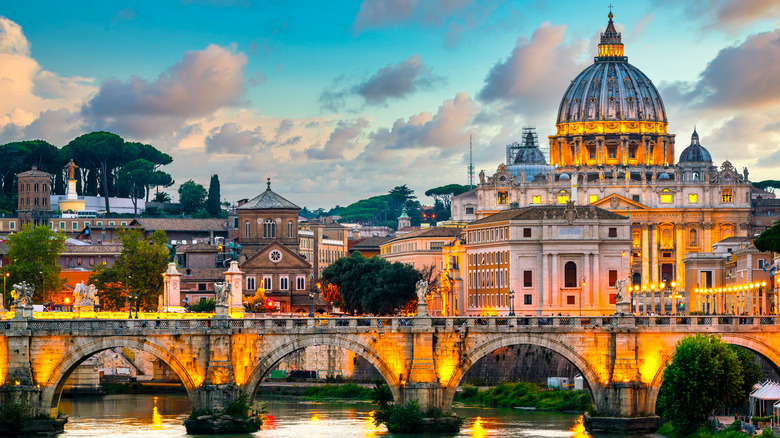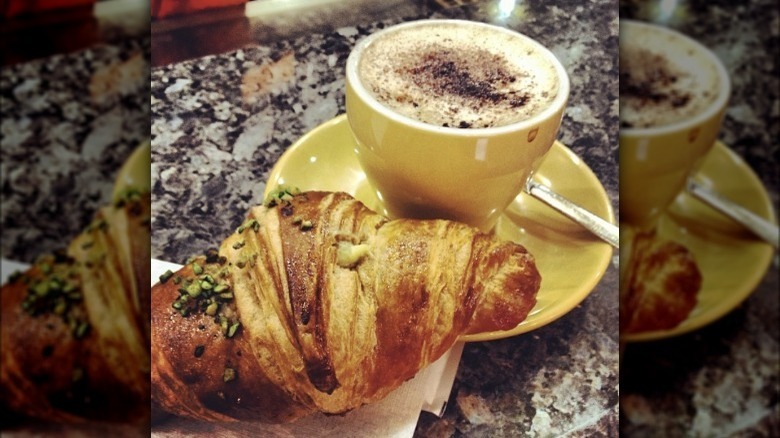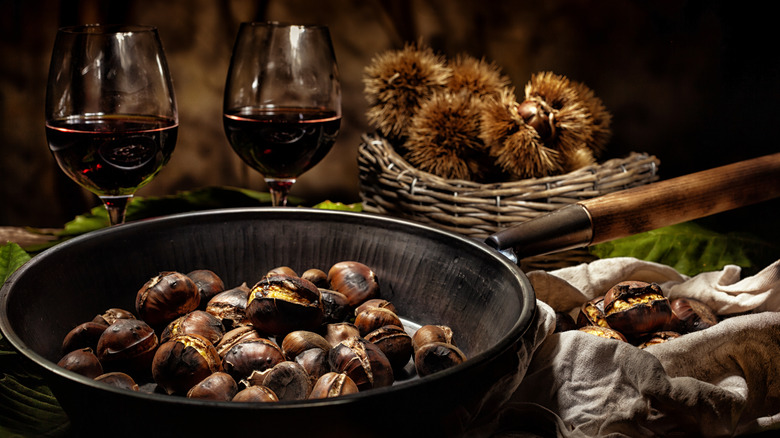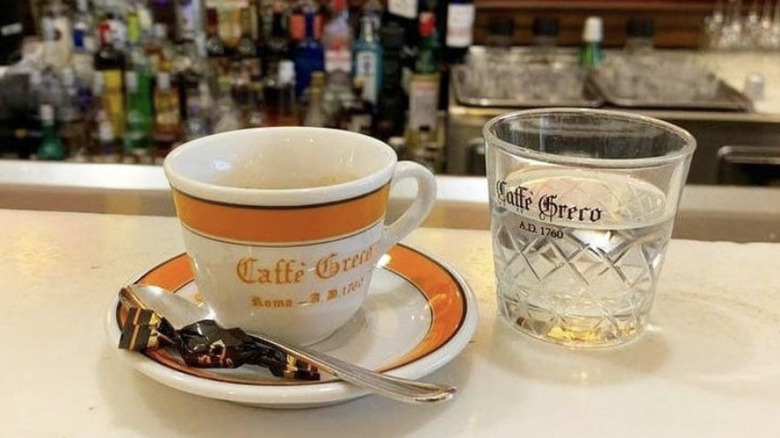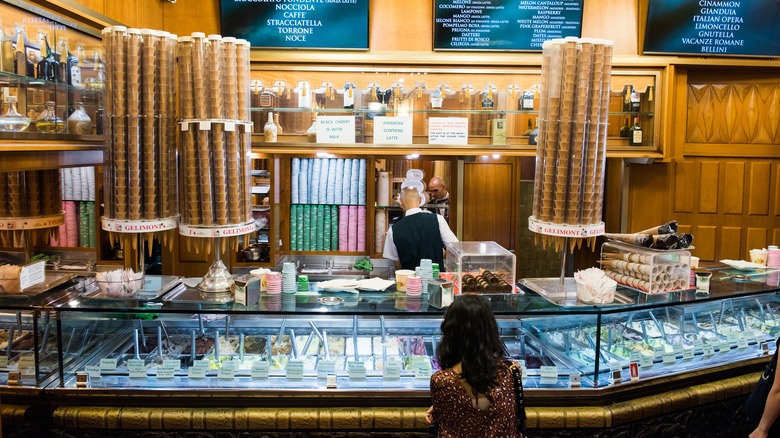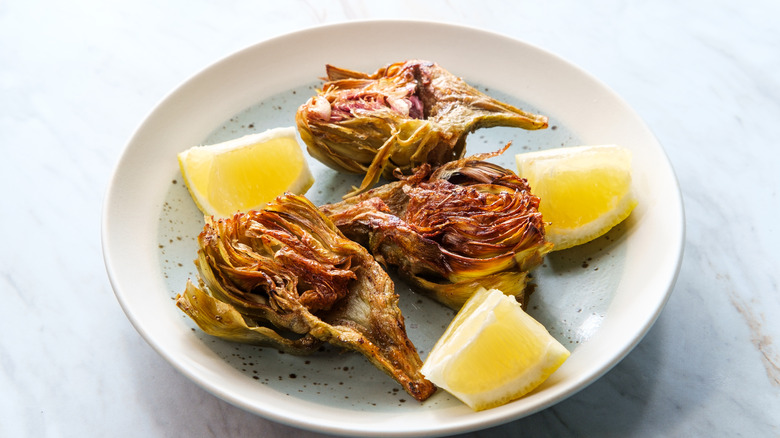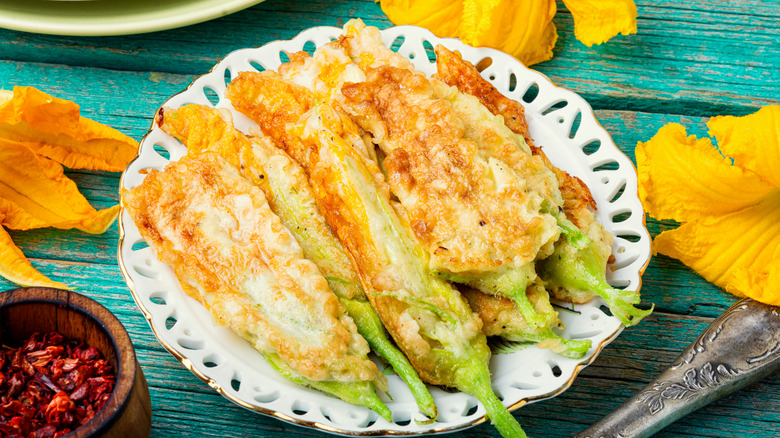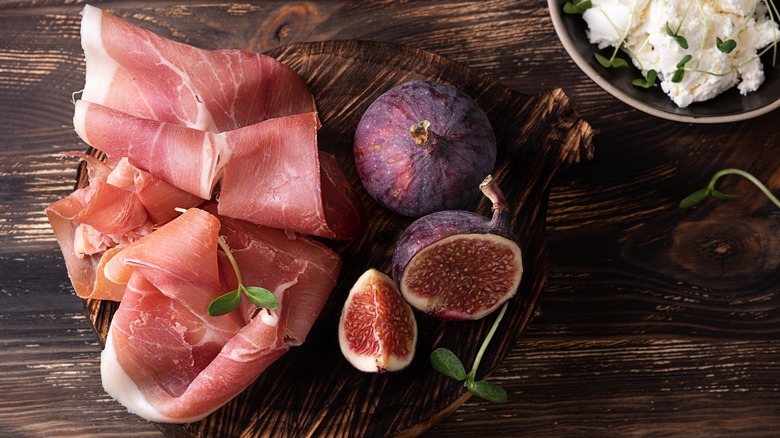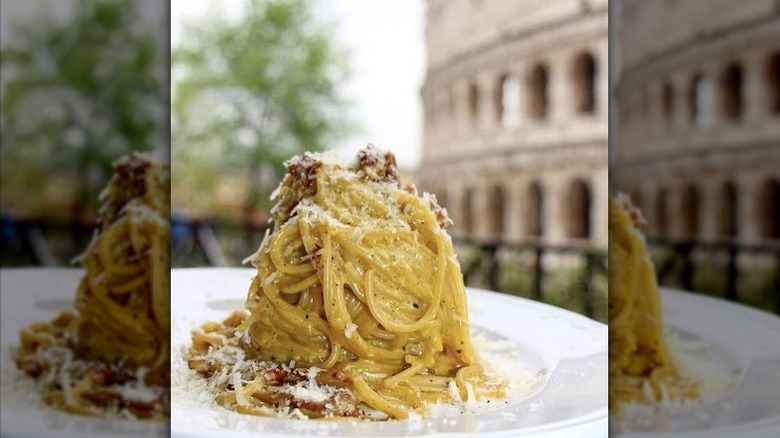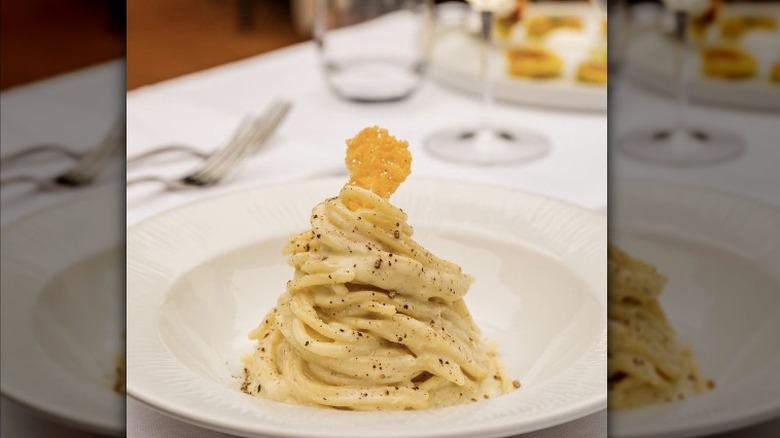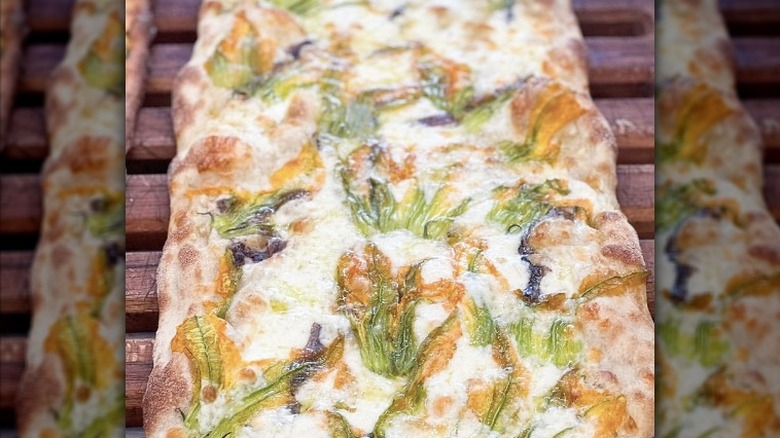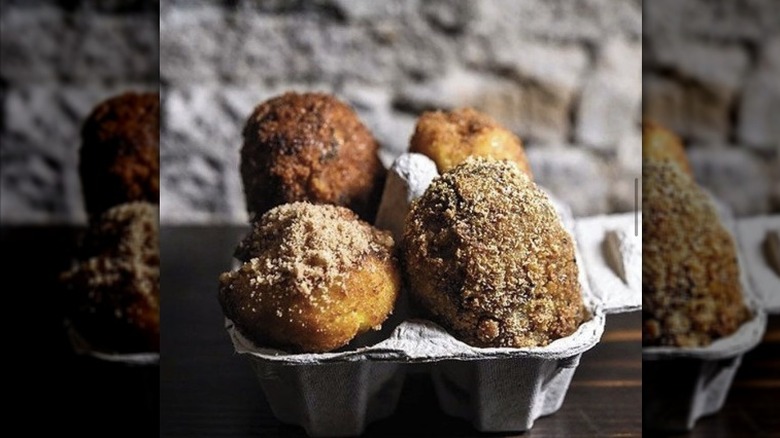14 Foods And Drinks You Have To Try In Rome, Italy
One of the great ancient cities of the world, Rome is a booming metropolis and concurrent archaeological site located in the Lazio region of central Italy. To say the city is picturesque is an understatement. From its classical and baroque architecture to its grand monuments like the Colosseum, Pantheon, and Trevi Fountain, all of which are incessantly flanked with shutter-snapping tourists, each turn of the head provides a breathtaking view of something spectacular nodding to Rome's storied past. Walking through the busy streets and palazzos of the city center provides glimpses of masterpieces like the Capitoline Wolf, Trajan's Column, and the goddess Victoria, or sculptures by legendary artists like Bernini, such as the Fountain of Four Rivers in the Piazza Navona (via Strictly Rome). The city is an opulent feast for the eyes.
Rome is also a gastronomic paradise drenched in centuries of tradition, culture, cuisine, and wine. One of the best ways to learn about the culture of a city or country is to explore its gastronomy. Roman cuisine was developed over centuries with a devotion to regional agriculture and aquaculture. It might go without saying, but the cuisine of Rome is uniquely Roman (via "DK Eyewitness Travel Italy"). Roman pizza differs from the pizza in Naples, Roman gelato is a thing of magic, Roman pasta is flavored with local ingredients, and even Rome's vegetables are steeped in history. So, do as the Romans do and nibble along the way.
Roman confections
Italians have made crafting pastry an art form. From gorgeous and gilded little cake creations to miniature pastry tarts filled with pastry crème and topped with seasonal fruit, pinon nuts, or crumbled walnuts, Italian pastries are visually and gastronomically satisfying. In Rome, pastry takes on regional flare and flavors from the nearby countryside. Ricotta cheese often makes an appearance as a sweetened filling for pastries from Sicily to Milan. Made in Lazio from buffalo, cow, goat, or sheep milk, ricotta is a staple of sweet and savory Roman cuisine and may have roots in ancient Rome, reports CNN.
Pastries from Rome and the surrounding regions include honey or sugar-sweetened ricotta as the delicious filling for cannoli and castagnole, which are little puffs of deep-fried pastry the size of a castagna (chestnut). Castagnole are also filled with chocolate cream, nut pastes, and pastry cream, as are larger bombolone Laziale, which are sugar-coated filled doughnuts. Think pastry cream, hazelnut chocolate, fig jam, or citrus-infused ricotta filling oozing from piping hot deep-fried pockets of sweetened dough. Lazian torta di ricotta is a Roman-style cheesecake filled with ambrosial marsala wine and lemon, reports "DK Eyewitness Travel Italy." Zabaione and brutti ma buoni (hazelnut meringues) are popular and delicious Roman confections, per "Tasting Rome" by Katie Parla.
Stop by L'Antico Forno near the Trevi Fountain or Pasticcerie Danieli for a steaming cappuccino and a warm cornetti (croissant) or sfogliatella filled with a delicate pale green pistachio crème for a morning treat.
Castagne (chestnuts)
Castagna (chestnut) trees are ubiquitous in Italy from north to south. The majestic tree provides shade in the summer and delicious fruit in the autumn. La Cucina Italiana suggests that Italians have been enjoying the delectable little nut since ancient times. It is a starchy yet soft nut packed in a dark auburn-hued shell that is loaded with nutrition, fiber, protein, and antioxidants, per Healthline. Piping hot castagne are a traditional holiday treat that can be purchased in little paper bags from street vendors roasting chestnuts over an open wood fire across much of Europe each winter. If you are lucky to have an open fireplace, roast your own castagne in iron skillets over a flame or try roasting them in a hot oven for your holiday table, per La Cucina Italiana.
Not just a winter holiday treat, castagnes have delicate, earthy, nutty flavors and a slight sweetness that lends itself to savory and sweet dishes all year round. Castagne are wonderful additions to classic Italian dishes like risotto or filled pasta like agnolotti. They pair perfectly with mushrooms alongside roasted meats and vegetables. They are delicious when blended into whipped cream with cocoa and a dash of espresso. Each autumn, castagne crème is used to fill pastries topped with shaved chocolate and candied citrus peel. Fragrant castagne gelato is a specialty in Rome.
Italian caffé
Italians take their caffé (coffee) seriously and enjoy it strong and straight. Caffé bars are abundant across Rome and most serve sweet and savory treats, sandwiches, and other delectables alongside espresso. The Roman Food Tour suggests that espresso drinks are ordered at the counter and often drunk there, standing up. Counter service is cheaper and faster than table service. Espresso is brewed in a specialty machine that works by forcing steamed water over a small lever containing pressurized espresso powder to "pull a shot" of caffé, according to Lavazza. In addition to being an afternoon pick-me-up or an after-dinner digestive (digestif), espresso makes frequent appearances in Italian confections, including in classic tiramisu.
Milky lattes are less traditional in Rome, and Italy, for that matter, but can be found. When Romans drink coffee with milk, it is with breakfast and it is called a cappuccino. Cappuccinos are made by pulling a shot or two of espresso into a small, warmed coffee cup and topping it with a scant amount of steamed milk and a hefty dollop of firm milky foam, per Lavazza. Cappuccinos can be sprinkled with cocoa, cinnamon, cardamom, nutmeg, or sugar, and are gently stirred, blending the flavors before being sipped slowly, savoring the experience. Visit Antico Caffè Greco a Via dei Condotti, 86. It opened in 1760, making it one of the third oldest cafes in the world.
Gelato
Once you go gelato, you never go back. Gelato is a rich Italian frozen treat crafted from milk, cream, and sugar, and is often flavored with fresh fruit, liqueurs, spices, herbs, and nuts. Food Network distinguishes Italian gelato from American ice cream because it has a silkier, denser texture than ice cream. Gelato uses more milk and less cream and omits egg yolks. It isn't as creamy as ice cream and is served slightly warmer to highlight its delectable flavors. Classic gelato flavors include pistachio, lemon, strawberry, raspberry, chestnut, vanilla, hazelnut, mint, cinnamon, chocolate, and basil. Adventurous gelato artisans experiment with flavors including wine, spirits, and international flavors like lychee and yuzu.
You can find gelateria shops on just about every corner of the city, but if you're visiting, naturally you'll want to find the best gelato in Rome. Visit Palazzo del Freddo di Giovanni Fassi, family-owned and Rome's oldest gelateria, dating back to 1880, for a cup or cone of plush gelato; frozen gelato cake is also a nice treat. The most important thing to remember when buying gelato is to look for seasonal flavors and subtle colors to ensure quality and authenticity.
Artichokes
National Geographic indicates that artichokes, the edible flower bud of a thistle plant native to the Mediterranean regions of North Africa, Italy, and Greece, made an appearance on Greco-Roman tables as early as 2,500 years ago. Artichokes became a staple on Roman tables during the Roman Empire and Renaissance, when the flower bud was considered an aphrodisiac. Still prized today for their uniquely bold flavor and rustic texture, artichokes are also rich in potassium, vitamin C, and fiber, according to Britannica. The Roman variety of artichoke, called the carciofi romaneschi, lacks the internal downy choke that must be removed before eating the tender heart, per Falstaff.
Particularly popular in Trastevere, the old Jewish section of Rome, carciofi alla giudia, as the dish is called there, is a crispy, double-deep-fried artichoke served with lemon. The classic Roman artichoke preparation, carciofi alla Romana, is slowly cooked with ample garlic and aromatic herbs, flavoring the tender artichoke hearts, which can be blended into a rough paste to be spread on bruschetta or blended into pasta dishes, per "Tasting Rome."
Marinated artichoke hearts are commonly found on antipasti platters, and finely minced artichoke hearts blended with Pecorino Romano cheese, lemon, olive oil, and herbs make a delectable spread on bruschetta.
Fiori di Zucca
Fiori di zucca are the gorgeous saffron orange blossoms of zucchini and squash plants. Fiori di zucca have a delicate but uniquely earthy, floral aroma and taste that intrigues the palate while their beautiful color tantalizes the eyes. All About Gardening reports that there are 15 types of zucchini and dozens of types of squash, each producing delicious blossoms. Italians cultivated the modern zucchini in the 19th century. A Roman delicacy, zucchini flowers are eaten raw on salads, prepared as frittered appetizers, and found atop pizza, pasta, and pancakes.
Fiori di zucca fritters are delicious and easy to prepare. According to "Tasting Rome," the delicate blossoms are stuffed with thin strips of buffalo mozzarella and a thin anchovy filet being before battered in a blend of flour and sparkling water. Then, the petals are pinched closed before the stuffed flower is slipped into piping hot oil for a few minutes until evenly browned.
Fiori di zucca is a staple on Roman pizza during late summer and autumn. Arrange a handful of fiori di zucca in a beautiful pattern on top of fresh pizza dough drizzled with olive oil. Add a generous sprinkling of mozzarella and bake at a high temperature until the crust is crispy and the cheese melts. If you visit Rome in late summer and autumn, fiori di zucca will be everywhere.
Wine from Rome and Lazio
Central Italy is known for its idyllic rolling hillsides lined with sun-kissed vineyards. Exploring Italian wine country exposes hundreds of wine regions from north to south and west to east. Vinology reports 20 main Italian wine regions, and 398 regions in total. Italy is a country devoted to vino. Lazio is known for its aromatic white wines, such as Frascati, per Wine Folly.
"Some of the oldest vineyards in the world are in Lazio," Giovanni Cilento told Tasting Table. Cilento is the sales manager for Ômina Romana, a vineyard and winery just 25 miles south of Rome in the ancient town of Velletri, overlooking the Tyrrhenian Sea. "One of our vineyards dates back to 600 B.C., and the Etruscans and Greeks. They've been under vine since. Archeological research shows four distinct layers of volcanic soil in between layers of limestone, sandstone, and clay. It is fertile and well-draining, perfect for grapes," Cilento says. "We grow ancient varietals like viognier, incrocio manzoni, petit manseng, and cenanese, and French wine varietals like cabernet sauvignon, merlot, cabernet franc, and chardonnay." Ômina Romana 2020 Linea Ars Magna Viognier received a coveted 3-Glasses award at the Gambero Rosso 2023 Tri Bicchieri awards in October 2022, a top prize for Italian wines and a true honor nodding to the past and celebrating Ômina Romana's bright future.
Cured Italian prosciutto
Italians have been salt-curing meat, particularly pork, since the time of ancient Rome, and likely before that. Walking around the city, you will spot specialty food shops with legs of cured prosciutto and packages of shaved prosciutto and crudo displayed prominently in windows. Dip inside the door and you will find stacks of Roman cheeses, bottles of olive oil, olives in brine, and crusty bread just begging to be turned into a picnic. Look for prosciutto di parma, di Modena, di Toscana, and di San Daniele, all protected designation of origin (DOP) certified to ensure the very best quality and authenticity.
There are dozens of types of cured meats from across the globe, and Italian prosciutto is one of the most famous. Italians use specific heritage hogs that are fed equally specific diets to produce their prized prosciutto, sought after for its delicate sweet and salty flavors and significant creamy marbling. Prosciutto is crafted across the Italian peninsula and is central to Italian cuisine. The salt-curing technique dates back to ancient Greece and was adopted by early Romans, making it a delicious Roman tradition, per Food Processing History.
Spaghetti alla Carbonara
Rich and silky spaghetti alla carbonara is another delicious pasta dish that is likely native to Rome, per Taste Atlas. The saucy cheese, egg, and pancetta, guanciale, or bacon delight is simple to prepare and found in trattorias across the city. La Cucina Italiana attempts to demystify the vague origins of the dish, often attributed to poor American soldiers stationed in Italy during World War II. The first known mention of the dish dates back to a circa 1839 regional cookbook. Carbonara officially appeared in the 1954 cookbook, Italian Food. No matter its origins, spaghetti alla carbonara is a signature dish of Rome and one not to be missed. Don't worry, with all of the sights to see and hilly, winding streets, you will walk off the calories in no time.
Use a long, thin pasta like spaghetti, bucatini, or fettuccine as the base for the dish. Whisk a few eggs and crumbled crispy guanciale (or bacon, pork belly, and pancetta) together before tossing it with the hot pasta of your choice. Finish with a hefty sprinkling of Pecorino Romano cheese and freshly ground pepper. That's it. Carbonara purists won't deviate from the classic dish but new riffs on carbonara include fresh, smoked, or canned seafood like anchovies, and vegetables such as asparagus, artichokes, or arugula. Add a few fiori di zucca for a gorgeous presentation. Find the classic dish at La Carbonara in Campo di Fiori or Osteria da Fortuna in Rome and Milan.
Limoncello liqueur
Limoncello liqueur is a refreshingly tangy-sweet lemon-infused liqueur crafted in homes, restaurants, and spirits producers across the southern regions of Italy. While limoncello is not native to Rome, it is sold in shops and served in restaurants across the city. Limoncello was first crafted along the Amalfi coast from aromatic Sorrento lemons. Limoncello comes in two styles, a crystalline yellow liquid or a creamy style. Both are equally potent and aromatic, and should be sipped icy cold out of petite sherry glasses.
According to Rick Steves Travel, Italy is the top producer of lemons globally, so it is fitting they would produce a delicious lemon-scented liqueur to please the palate. Most often, limoncello is sipped after dinner as a digestivo, but the lemon-flavored libation finds its way into confections and cocktails alike. Classic limoncello is made by steeping lemon zest and sugar in a clear spirit like vodka until the spirit is richly colored and fragrant. Limone di Sorrento IGP (Protected Geographic Indication) is said to be the best quality limoncello available. Pick up a bottle or two to bring home or try making your own limoncello for a sweet reminder of Rome.
Cacio e pepe
Cacio e pepe is a modern Roman creation. It is a delicious yet simple dish crafted from a regional sheep milk cheese called Pecorino Romano (cacio) and a sprinkling of pepper (pepe). Just three ingredients, that's all. Anthony Bourdain quipped that cacio e pepe "could be the greatest thing in the history of the world" on one episode of No Reservations; as simple as it sounds, it is challenging to prepare perfectly, reports BBC Travel,
La Cucina Italiana suggests that the trick to perfect cacio e pepe is expertly blending just the right amount of finely grated Pecorino Romano cheese with the hot and starchy cooking water to emulsify the cheese, creating a luscious sauce that deftly coats each piece of tonnarelli or spaghetti. One mistake will leave a clunky mass of cheesy bits that stick the spaghetti together in clumps. Authentic Roman cacio e pepe never adds butter, oil, or flour as a thickener.
Finding just the right plate of cacio e pepe in Rome can be a challenge. Too many restaurants cut corners and add thickeners or butter to their sauce. Look for traditional trattorias with tableside service for the best cacio e pepe. Check out Felice in Testaccio or Antica Pesa for an exemplary display of the classic Roman dish.
Roman pizza — pizza al taglio
What is it about pizza that makes everyone happy? With its warm and yeasty crust topped with simple ingredients, pizza is considered the perfect food by pizza lovers across the globe. Better yet, pizza is destined to be eaten with one's hands. Italians are fiercely protective of their pizza and Neapolitan Pizzaiuolo process, from crafting the dough to throwing the crust and baking the pizza in a wood-fired oven. The process even earned the coveted UNESCO status in 2017 for contributing to the intangible cultural heritage of Italy, reports UNESCO.
MasterClass suggests that Roman pizza, or pizza al taglio, differentiates itself from its more famous cousin because it is made on a rectangular sheet pan and has a unique, slightly thicker crust. Roman pizza is unique for several reasons, one being that it takes longer to bake. Look for seasonal toppings such as a blend of regional cheeses, tomatoes and basil with a drizzle of olive oil, fiori di zucca and mozzarella, prosciutto and figs, potato and guanciale with Pecorino Romano cheese, artichokes and cheese, or mushrooms and sausage. It can be found in pizzerias and bakeries across Rome and is sold by the slice or kilo and served in a waxed paper sleeve. "Tasting Rome” indicates that thin and rimless-crust individual pizza is becoming popular in specialty pizzerias across the city like Pizzeria da Baffetto in the Piazza Navona.
Supplì di Riso
Every country or region has its favorite street food. In Rome, supplì di riso fits that bill. Supplì di riso are piping hot little croquettes of rice filled with meat, eggs, cheese, and vegetables. Supplì are smaller than arancini, which are commonly found in southern Italy and across the United States on Italian immigrant holiday tables. "Tasting Rome" reports that supplì classici are stuffed with chicken liver, pork sausage, and mozzarella cheese.
Supplizio Roma is one of the best supplì spots in Rome. Located just west of the Piazza Navona near the Tiber River, master supplì chef Arcangelo Dandini crafts classic Roman flavors like Pecorino cheese-and-pepper-filled cacio e pepe and cheesy bacon and egg carbonara into his elevated supplì. The deep-fried little balls of stuffed rice are crunchy and browned on the outside and decadently creamy on the inside. The name supplì supposedly comes from the French word Surprise, a reference to the yummy goodies hidden inside the rice croquette. Supplì are often served with marinara for dipping, but great supplì are perfect on their own.
Filetti di Baccalà
Filetti di baccalà are plump deep-fried cod filets and a mainstay of modern Roman cuisine (via Serious Eats). Originally a Sephardic Jewish street food specialty, the cod fritter is popular across much of Italy and the Mediterranean. Cod fritters can be found in seaside regions from Italy west to Portugal and are a delicious mainstay in England when served with deep-fried potato slices as fish and chips.
Cod isn't native to the Tyrrhenian Sea near Rome, but centuries of cod trading brought the fish to Italian shores. History Today reports that most salt cod comes from the icy Atlantic waters from North America to the Barents Sea above Norway. Cod was a staple for native North Americans, Scandinavians, and early Europeans. Eighth-century Viking explorers began to air-dry cod for sustenance on explorations to North America and across the European continent. In the 1600s, Porto, Portugal became a trading hub for salt cod. The fish eventually became an important ingredient in Iberian, French, and Italian gastronomy. So began the dried cod and salt cod trade.
Filetti di baccalà uses dried salt cod that has been soaked and rinsed to remove the salt residue and reconstitute the fish. After dredging the fish in a blend of flour, white wine, and egg, the battered fish is carefully fried until crisp and browned. Romans serve filetti di baccalà with fresh lemon wedges. Look for it in trattorias and street food stands across Rome.
